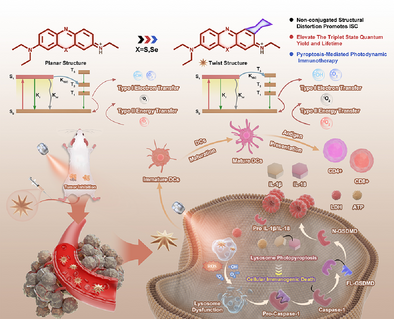Nonconjugated Structural Distortion Promoting the Formation of NIR Triplet States in Phenothiazine Dyes for Cancer Photoimmunotherapy
Graphical Abstract
Through steric modification of PTZ dyes, we developed a nonconjugated structural distortion strategy that enhances ISC efficiency and prolongs triplet-state lifetime via optimized spin–orbit coupling. The optimized photosensitizer HNBS achieves oxygen-independent tumor ablation at ultralow doses while inducing pyroptosis-mediated immunogenic cell death for synergistic photoimmunotherapy.
Abstract
Near-infrared (NIR) triplet-state dyes are pivotal for advanced biomedical and material science applications. Although numerous strategies have been proposed to enhance the photosensitization efficiency of dyes, significant challenges remain. Herein, we propose a novel strategy leveraging nonconjugated structural distortion to enhance triplet-state formation. This strategy, achieved by introducing steric groups at the edges of the phenothiazine (PTZ) dye framework, notably enhances intersystem crossing (ISC) and prolongs triplet-state lifetime. Based on this strategy, HNBS and HNBSe are synthesized, which exhibit exceptional triplet-state quantum yields (47.2% for HNBS and 87.7% for HNBSe) and prolonged triplet-excited-state lifetimes (21.1 µs for HNBS and 6.3 µs for HNBSe). These values substantially exceed those of conventional dyes, such as NBS (negligible and NBSe (3.2 µs). Under ultralow-light doses (0.45 J cm−2 in vitro, and 6 J cm−2 in vivo), these photosensitizers demonstrate robust tumor cell inhibition, highlighting their exceptional photosensitizing ability. Mechanistically, HNBS possesses lysosomal-targeting ability, and upon light irradiation, it induces lysosomal damage, triggering pyroptosis and immunogenic cell death. These processes promote dendritic cell maturation and T-cell differentiation, augmenting the immune response and enabling effective photoimmunotherapy.
Conflict of Interests
The authors declare no conflict of interest.
Open Research
Data Availability Statement
The data that support the findings of this study are available in Supporting Information of this article.





